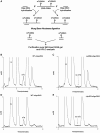Identification of novel methyltransferases, Bmt5 and Bmt6, responsible for the m3U methylations of 25S rRNA in Saccharomyces cerevisiae
- PMID: 24335083
- PMCID: PMC3950682
- DOI: 10.1093/nar/gkt1281
Identification of novel methyltransferases, Bmt5 and Bmt6, responsible for the m3U methylations of 25S rRNA in Saccharomyces cerevisiae
Abstract
RNA contains various chemical modifications that expand its otherwise limited repertoire to mediate complex processes like translation and gene regulation. 25S rRNA of the large subunit of ribosome contains eight base methylations. Except for the methylation of uridine residues, methyltransferases for all other known base methylations have been recently identified. Here we report the identification of BMT5 (YIL096C) and BMT6 (YLR063W), two previously uncharacterized genes, to be responsible for m3U2634 and m3U2843 methylation of the 25S rRNA, respectively. These genes were identified by RP-HPLC screening of all deletion mutants of putative RNA methyltransferases and were confirmed by gene complementation and phenotypic characterization. Both proteins belong to Rossmann-fold-like methyltransferases and the point mutations in the S-adenosyl-L-methionine binding pocket abolish the methylation reaction. Bmt5 localizes in the nucleolus, whereas Bmt6 is localized predominantly in the cytoplasm. Furthermore, we showed that 25S rRNA of yeast does not contain any m5U residues as previously predicted. With Bmt5 and Bmt6, all base methyltransferases of the 25S rRNA have been identified. This will facilitate the analyses of the significance of these modifications in ribosome function and cellular physiology.
Figures









Similar articles
-
Identification of a novel methyltransferase, Bmt2, responsible for the N-1-methyl-adenosine base modification of 25S rRNA in Saccharomyces cerevisiae.Nucleic Acids Res. 2013 May 1;41(10):5428-43. doi: 10.1093/nar/gkt195. Epub 2013 Apr 4. Nucleic Acids Res. 2013. PMID: 23558746 Free PMC article.
-
Yeast Rrp8p, a novel methyltransferase responsible for m1A 645 base modification of 25S rRNA.Nucleic Acids Res. 2013 Jan;41(2):1151-63. doi: 10.1093/nar/gks1102. Epub 2012 Nov 23. Nucleic Acids Res. 2013. PMID: 23180764 Free PMC article.
-
Yeast Nop2 and Rcm1 methylate C2870 and C2278 of the 25S rRNA, respectively.Nucleic Acids Res. 2013 Oct;41(19):9062-76. doi: 10.1093/nar/gkt679. Epub 2013 Aug 2. Nucleic Acids Res. 2013. PMID: 23913415 Free PMC article.
-
'View From A Bridge': A New Perspective on Eukaryotic rRNA Base Modification.Trends Biochem Sci. 2015 Oct;40(10):560-575. doi: 10.1016/j.tibs.2015.07.008. Trends Biochem Sci. 2015. PMID: 26410597 Review.
-
Eukaryotic ribosomal RNA: the recent excitement in the nucleotide modification problem.Chromosoma. 1997 Jun;105(7-8):391-400. doi: 10.1007/BF02510475. Chromosoma. 1997. PMID: 9211966 Review.
Cited by
-
Chemical Modifications of Ribosomal RNA.Methods Mol Biol. 2022;2533:149-166. doi: 10.1007/978-1-0716-2501-9_9. Methods Mol Biol. 2022. PMID: 35796987 Free PMC article.
-
Hypoxia induces alterations in tRNA modifications involved in translational control.BMC Biol. 2023 Feb 21;21(1):39. doi: 10.1186/s12915-023-01537-x. BMC Biol. 2023. PMID: 36803965 Free PMC article.
-
Identification of the 3-amino-3-carboxypropyl (acp) transferase enzyme responsible for acp3U formation at position 47 in Escherichia coli tRNAs.Nucleic Acids Res. 2020 Feb 20;48(3):1435-1450. doi: 10.1093/nar/gkz1191. Nucleic Acids Res. 2020. PMID: 31863583 Free PMC article.
-
Structural and functional studies of Bud23-Trm112 reveal 18S rRNA N7-G1575 methylation occurs on late 40S precursor ribosomes.Proc Natl Acad Sci U S A. 2014 Dec 23;111(51):E5518-26. doi: 10.1073/pnas.1413089111. Epub 2014 Dec 8. Proc Natl Acad Sci U S A. 2014. PMID: 25489090 Free PMC article.
-
NEP-TC a rRNA Methyltransferase Involved on Somatic Embryogenesis of Tamarillo (Solanum betaceum Cav.).Front Plant Sci. 2019 Apr 5;10:438. doi: 10.3389/fpls.2019.00438. eCollection 2019. Front Plant Sci. 2019. PMID: 31024602 Free PMC article.
References
-
- Ben-Shem A, Garreau de Loubresse N, Melnikov S, Jenner L, Yusupova G, Yusupov M. The structure of the eukaryotic ribosome at 3.0 A resolution. Science. 2011;334:1524–1529. - PubMed
-
- Lilley DM. The ribosome functions as a ribozyme. Chembiochem. 2001;2:31–35. - PubMed
-
- Klootwijk J, Planta RJ. Analysis of the methylation sites in yeast ribosomal RNA. Eur. J. Biochem. 1973;39:325–333. - PubMed
-
- Brand RC, Klootwijk J, Van Steenbergen TJ, De Kok AJ, Planta RJ. Secondary methylation of yeast ribosomal precursor RNA. Eur. J. Biochem. 1977;75:311–318. - PubMed
-
- Decatur WA, Fournier MJ. rRNA modifications and ribosome function. Trends Biochem. Sci. 2002;27:344–351. - PubMed
Publication types
MeSH terms
Substances
LinkOut - more resources
Full Text Sources
Other Literature Sources
Molecular Biology Databases

